100+ Top Influencer Marketing Statistics (2024 Industry Data)
Want to learn more about the state of influencer marketing this year?
We’ve updated our roundup of influencer marketing statistics with up-to-date facts and figures pulled from the latest industry reports and surveys.
Below, you’ll find a ton of eye-opening stats that reveal more about influencers, the brands that work with them, and the marketing strategies and trends that are shaping the industry.
Editor’s picks
- Influencer marketing is expected to grow to a market size of $17.4 billion this year (Collabstr)
- 83% of surveyed professionals say influencer marketing is still effective (Influencer Marketing Hub1)
- 82% of surveyed professionals say influencer marketing generates better results than other marketing methods (Influencer Marketing Hub1)
- 80% of companies will have dedicated influencer marketing budgets this year (Influencer Marketing Hub1)
- The top objective for influencer marketing is to generate UGC (Influencer Marketing Hub1)
- The average brand spends 25% of its total budget on influencer marketing (Aspire)
- The average cost of an individual influencer collaboration is $257 (Collabstr)
- 77% of influencers are female and 23% are male (Collabstr)
- 55.5% of influencer marketers use TikTok, making it the most popular social media platform for influencer marketing (Influencer Marketing Hub1)
- 63% of marketers plan to use AI to improve their influencer campaigns this year (Influencer Marketing Hub1)
General influencer marketing statistics
Let’s kick things off by looking at some general influencer marketing statistics that tell us more about the size and growth of the industry this year:
- The influencer marketing industry is expected to reach a market size of $17.4 billion this year
- That represents a 14.47% year-over-year growth. The market size was $15.2 billion in 2022.
- By 2025, the market is expected to reach $22.2 billion
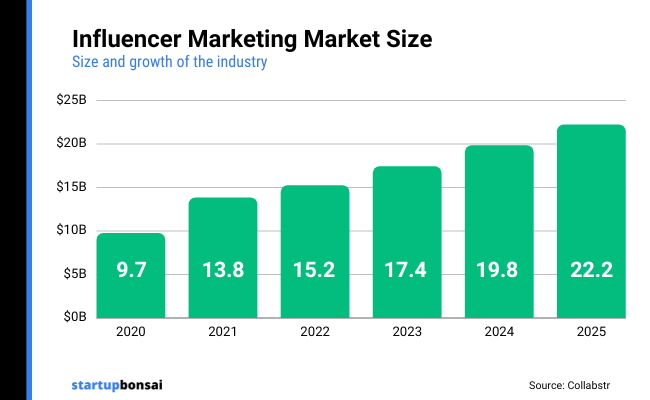
Source: Collabstr
- The market for influencer marketing software platforms is expected to grow to $223.7 million this year.
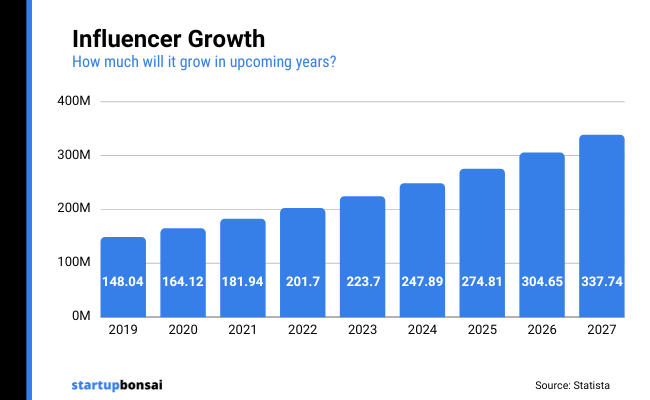
Source: Statista2
- There were around 18,900 companies globally that offer influencer marketing services in 2021
- That’s 75% more than there were in 2019
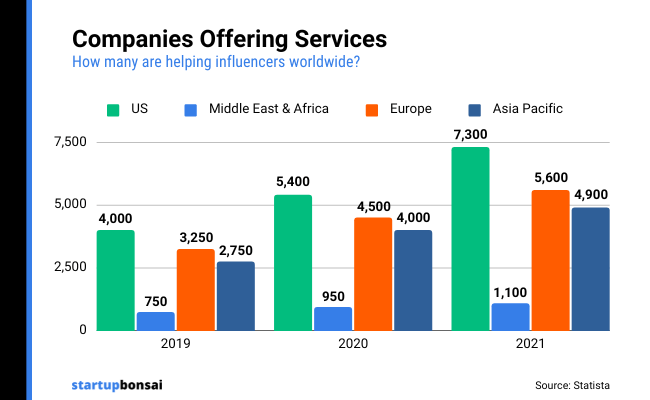
Source: Statista1
Influencer marketing usage statistics
How many companies are investing in influencer marketing? And what are the top use cases for influencer campaigns? Here’s what the statistics say:
- 80% of surveyed businesses will dedicate part of their budget to influencer marketing this year
- That’s 3% more than last year when 77% of businesses had a dedicated influencer marketing budget…
- …and more than twice as many as in 2017, when only 37% had a dedicated influencer marketing budget
- 45% of surveyed brands run influencer campaigns to drive user-generated content (UGC) creation. This makes it the top influencer marketing objective this year.
- 29% of surveyed brands use influencer marketing to generate sales
- 26% of surveyed brands use influence marketing to boost brand awareness
Source: Influencer Marketing Hub1
Is influencer marketing still effective?
According to Influencer Marketing Hub’s latest industry report:
- 83% of marketing professionals think influencer marketing is still effective
- That’s down slightly compared to last year when 90% said it was effective
Source: Influencer Marketing Hub1
To build on that point, here are some statistics that highlight the ways in which influencer marketing can be effective and the benefits it offers:
- 61% of consumers say they trust recommendations from influencers as much as their family…
- …whereas only 38% say they trust recommendations from brands
Source: ProfitBlitz
- 80% of consumers have bought something recommended by an influencer
Source: Rakuten
- Around 82% of surveyed companies say influencer marketing generates better customers than other types of marketing
Source: Influencer Marketing Hub1
- Healthcare companies can increase their target audience reach by 18x through influencer marketing…
- And generate 4.9x as many engagements. This makes healthcare the industry that can benefit most from influencer marketing.
- Companies in the accommodation niche also increase their reach by 18x through influencer marketing, on average…
- …and generate 4.2 as many engagements.
Source: Emplifi
Influencer marketing is also effective at generating content for brands to use elsewhere in their marketing and sales efforts:
- 63% of companies repurpose their influencer content on their branded social media accounts
- 56% of companies repurpose their influencer content in paid ad campaigns.
- 50% of companies repurpose their influencer content for website/product pages
- 43% of companies repurpose their influencer content in their email campaigns
- 9% of companies repurpose their influencer content in out-of-home activations (e.g. billboards)
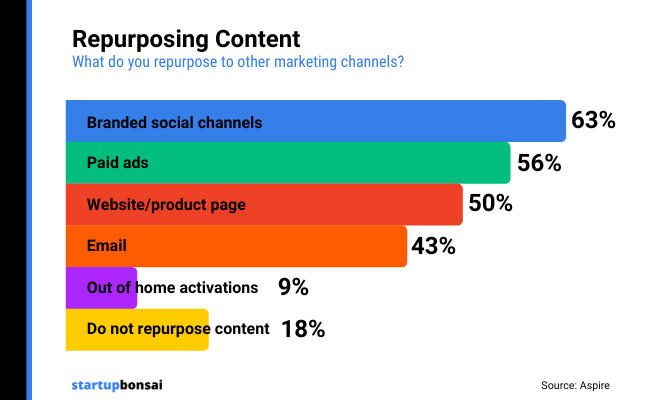
Source: Aspire
How much do brands spend on influencer marketing?
Multiple companies have conducted surveys and reports looking at how much brands spend on influencer marketing, with varying results. So the answer to this question varies depending on what source you look at.
According to data from Aspire:
- The average brand spends 25% of its marketing budget on influencer marketing
Source: Aspire
In a different report, Influencer Marketing Hub also asked survey participants what percentage of their marketing budgets they devoted to influencer marketing, and found that:
- 23% of companies plan to spend >40% of their budget on influencer marketing this year (That’s 5% more than last year)
- 18% of companies plan to spend 20-30% of their budget on influencer marketing
- 25% of companies plan to spend 10-20% of their budget on influencer marketing
- 20% of companies plan to spend <10% of their budget on influencer marketing
The same survey also asked how much brands spend annually in actual figures (rather than as a percentage of their total budget) and found that:
- 43% of companies spend <$10k on influencer marketing
- 22% of companies spend $10-50k on influencer marketing
- 14% of companies spend $50-100k on influencer marketing
- 11% of companies spend $500k on influencer marketing
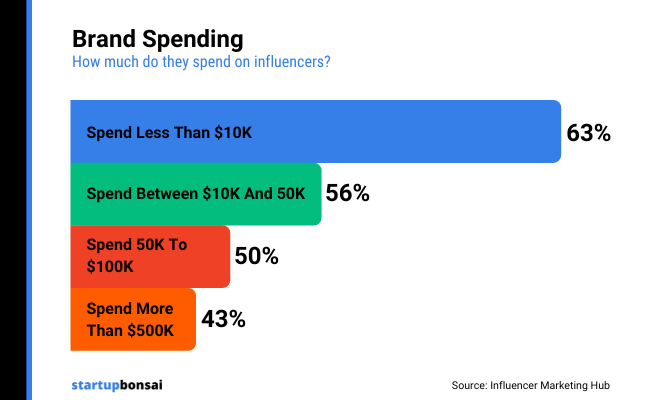
Source: Influencer Marketing Hub1
Creator IQ also looked at how much brands spend on influencer marketing annually. According to their latest report:
- 52% of brands spend >2k on influencer marketing
- 12% of brands spend $50-100k on influencer marketing
- 7% of brands spend $100-200k on influencer marketing
Source: Creator IQ & Tribe Dynamics
Here are some more statistics pulled from different studies that break down the costs of influencer marketing even further:
- Brands spend $257 per influencer collaboration, on average
Source: Collabstr
- Brands spend $49,594 per influencer marketing campaign, on average…
- …and $2,075 per creator per campaign.
Source: Aspire
- 20% of brands employ 6+ influencer marketers
- 35% of brands employ between 3 and 5 dedicated influencer marketers
- 45% of brands employ between 0 and 2 influencer marketers
Source: Creator IQ & Tribe Dynamics
- 67% of brands have plans to increase their influencer marketing spending this year
- 15% of brands plan to keep their budget the same this year
- 7% of brands plan to decrease their budget this year
- 11% of brands don’t know how their budget will change this year
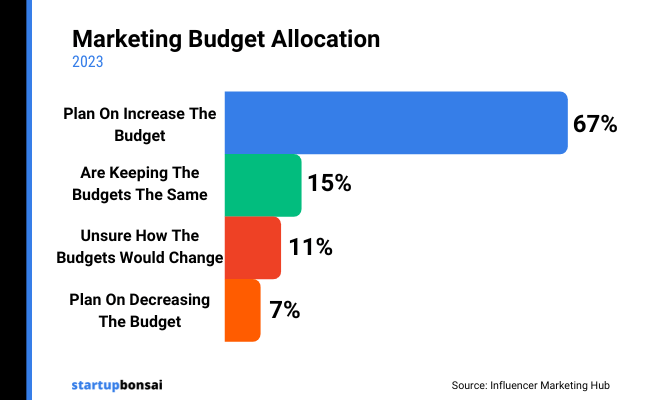
Source: Influencer Marketing Hub1
How do brands pay influencers?
Next, let’s look at some statistics that reveal how brands are paying for their influencer collaborations this year.
- 41.6% of brands pay influencers through monetary compensation (i.e. real money)
- 29.5% of brands pay influencers with free products
- 17.7% of brands pay influencers through discounts on their products
- 11.2% of brands pay influencers through entries into giveaways
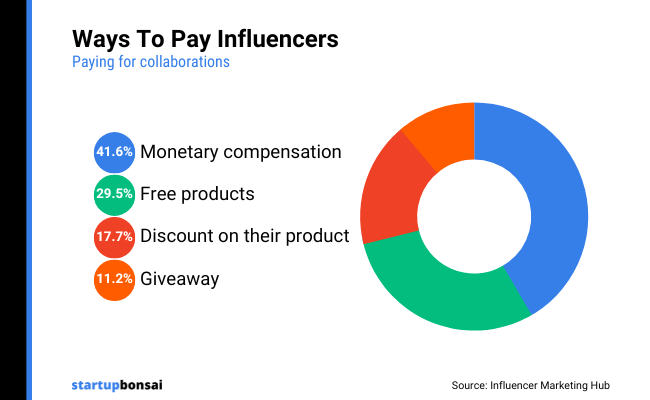
Source: Influencer Marketing Hub1
While less than half of all brands still don’t pay influencers real money, the number that does is up significantly compared to last year.
And that’s good news for influencers because Emplifi’s survey of influencers found that:
- Cash is the #1 preferred payment by influencers
- Gift cards are the second most popular preferred payment type
- Free products are the third most popular preferred payment type
- Discounts are the fourth most popular preferred payment type
- Credit/content exposure is the fifth most popular preferred payment type
Source: Emplifi
Influencer Marketing Hub’s report also looked at the ways in which brands structure their payments to influencers, and found that:
- 53% pay influencers a percentage of sales
- 21% pay influencers based on the product level
- 19.6% pay influencers a flat rate for each partnership
- 6.9% offer tiered payment incentives
In terms of payment channels, the report found that:
- 29% of brands pay influencers through PayPal
- 28% of brands pay influencers via wire transfer
- 25% of brands pay influencers with manual payments
- 17% of brands pay influencers via other third-party payment services
Source: Influencer Marketing Hub1
How much do influencers charge?
Here’s what the data tells us about how much influencers charge on different platforms:
- YouTube influencers ask for $791 per collaboration, on average. This is more than any other platform.
- TikTok influencers ask for $460 per collaboration, on average.
- User-generated content (UGC) creators ask for $396 per collaboration, on average.
- Instagram influencers ask for $363 per collaboration, on average.
Note: UGC creators don’t share posts to a specific platform; they just provide the content.
The above statistics reveal the initial average asking price for collaborations, but the asking price is usually different from the amount influencers end up charging at the end of negotiations:
- Brands end up paying $418 to YouTube influencers per collaboration, on average
- Brands end up paying $203 to TikTok influencers per collaboration, on average
- Brands end up paying $227 to UGC influencers per collaboration, on average
- Brands end up paying $183 to Instagram influencers per collaboration, on average
Aside from by platform, the average price influencers charge also varies by niche. These are the top 10 most lucrative influencer niches, per Collabstr:
- Lifestyle influencers charge $994 per collaboration
- Fashion influencers charge $912 per collaboration
- Beauty influencers charge $860 per collaboration
- Travel influencers charge $939 per collaboration
- Model influencers charge $864 per collaboration
- Health & fitness influencers charge $979 per collaboration
- Comedy & entertainment influencers charge $968 per collaboration
- Food & drink influencers charge $918 per collaboration
- Music & dance influencers charge $850 per collaboration
- Art & photography influencers charge $818 per collaboration
Source: Collabstr
Here are a few more stats about how much influencers earn:
- 26% of influencers earn less than $500/month through content creation
- 15% of influencers earn over $5,000/month through content creation
- 83% of influencers will work with brands for free products if they like the brand or it’s a high-value product
Source: Aspire & Creator IQ & Tribe Dynamics
Influencer statistics
Next, let’s look at some statistics specifically about influencers:
- 77% of influencers are female, on average across platforms
- 79% of Instagram influencers are female.
- The average influencer monetizes two social platforms
Source: Collabstr
- 81% of influencers work solo
- 10% of influencers outsource some of their tasks
- 7% of influencers work with other freelancers
- 2% of influencers work with full-time employees
Source: Creator IQ & Tribe Dynamics
- 47% of influencers refer to themselves as ‘creators’
- 8% refer to themselves as ‘influencers’
- 45% use both the above terms interchangeably
Source: Creator IQ & Tribe Dynamics
- Nano-influencers (<10k followers) share sponsored posts 67% more often than mega-influencers (100k+ followers)
- Instagram influencers share around 7% of sponsored content compared to 93% of organic content
- Mega-influencers (100k+ followers) share 27% more video content than those with less than 50k followers
Source: Emplifi
Influencer marketing around the world
Next, let’s look at how popular influencer marketing is around the world.
According to Collabstr, the top 10 countries for influencer marketing (in ranked order), are:
- USA
- Canada
- UK
- Australia
- Germany
- Mexico
- France
- Spain
- Netherlands
- Italy
Source: Collabstr
And the top 10 cities with the most influencers in North America (in ranked order), are:
- Los Angeles, US
- New York, US
- Toronto, Canada
- Vancouver, Canada
- Atlanta, US
- Miami, US
- Chicago, US
- Houston, US
- Dallas, US
- Orlando, US
Source: Collabstr
- 82% of influencer marketing spend goes to influencers in the US
- 8% of influencer marketing spend goes to influencers in Canada
- 5% of influencer marketing spend goes to influencers in Australia
- 5% of influencer marketing spend goes to influencers in the UK
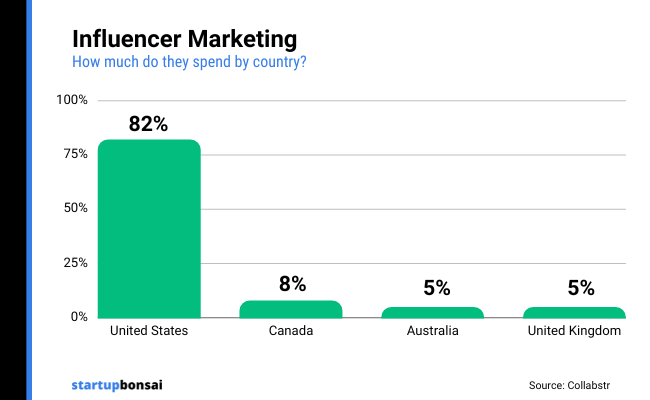
Source: Collabstr
What is the most popular influencer niche?
Collabstr looked at all the influencers on its marketplace and found that Lifestyle was the most popular niche that influencers operated in.
Here are the rest of the top 10 influencer niches in order of popularity, according to their data:
- Lifestyle
- Fashion
- Beauty
- Travel
- Model
- Health and fitness
- Comedy and entertainment
- Food and drink
- Music and dance
- Art and photography
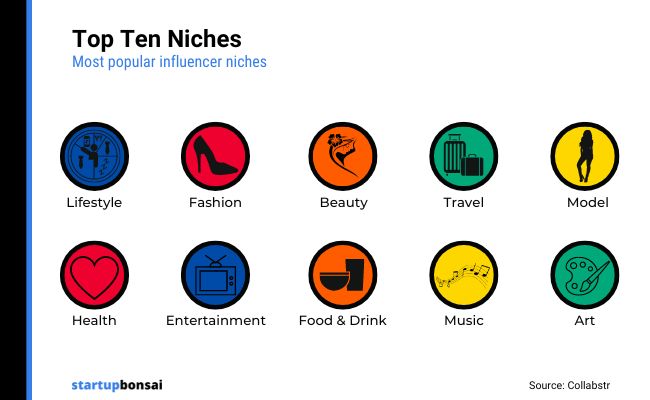
Source: Collabstr
Discrimination in influencer marketing
Do influencers experience discrimination? Here’s what the statistics say:
- 58.3% of influencers say they’ve experienced discrimination
- 41.7% of influencers said they haven’t experienced discrimination
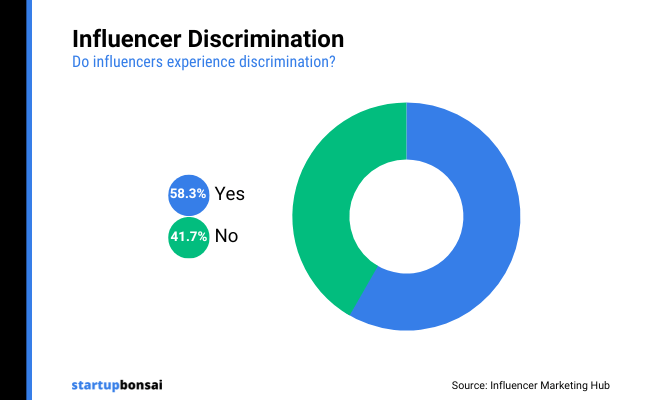
Source: Influencer Marketing Hub1
We can further break that down by social network:
- 58.4% of influencers have experienced discrimination on TikTok
- 13.6% of influencers have experienced discrimination on YouTube
- 12.9% of influencers have experienced discrimination on Instagram
- 10% of influencers have experienced discrimination on Facebook
Source: Influencer Marketing Hub1
The survey also asked about the specific types of discrimination influencers feel they’ve faced, and found that:
- 47.7% of influencers have faced discrimination based on gender
- 21.75% have faced discrimination based on their physical features
- 13.3% have faced discrimination based on their face
- 9% have faced discrimination based on political views
- 8% have experienced discrimination based on sexual orientation.
Source: Influencer Marketing Hub1
Influencer marketing campaign statistics
How long does the average influencer marketing campaign take? How frequently do brands run influencer campaigns? And what does the process look like? Here are some statistics that shed light on those questions:
- 48% of brands run influencer campaigns every month
- 18% of brands run influencer campaigns every quarter
- 15% of brands run influencer campaigns annually
Source: Influencer Marketing Hub1
- The average influencer collaboration takes 16 days to complete
- The average influencer responds to a brand proposal in 14 hours
Source: Collabstr
- The average influencer marketing campaign involves 188 posts
- The average influencer marketing campaign involves 46 creators
Source: Aspire
- 72% of brands run their influencer marketing campaigns in-house
Source: Influencer Marketing Hub1
What are the most popular social media platforms for influencer marketing?
Different surveys and reports have looked at what platforms brands and influencers most commonly like to collaborate on and have come to different conclusions.
Here’s a breakdown of the most important statistics from different sources.
According to Influencer Marketing Hub, TikTok is the most popular platform for influencer marketing this year:
- 55.5% of marketers use TikTok for influencer campaigns
- 50.8% of marketers use Instagram for influencer campaigns
- 42.1% of marketers use Facebook for influencer campaigns
- 38.3% of marketers use YouTube for influencer campaigns
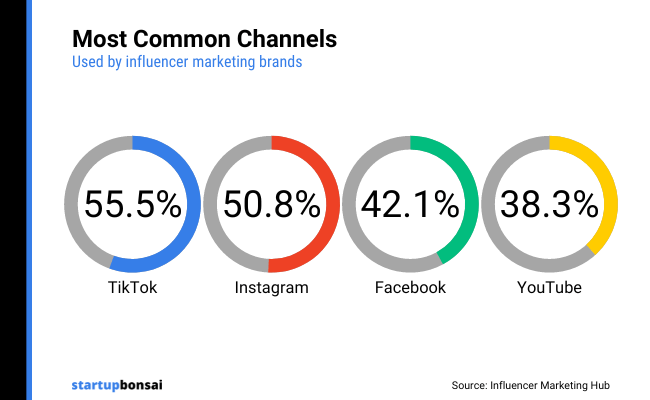
Source: Influencer Marketing Hub1
Collabstr also found that TikTok is the most popular platform for influencer marketing this year. According to their data:
- 45% of paid collaborations take place on TikTok
- 39% of paid collaborations take place on Instagram
- 2% of paid collaborations take place on YouTube
Source: Collabstr
However, Aspire’s study found different results. According to their survey:
- 87% of influencer marketers plan to utilize Instagram the most this year, making it the most popular platform for influencer marketing
- 68% plan to utilize TikTok
- 45% plan to utilize YouTube
- 41% plan to utilize Facebook
- 28% plan to utilize Blogger
- 22% plan to utilize Pinterest
- 18% plan to utilize Twitter
- 4% plan to utilize Snapchat
Source: Aspire
Aspire also found that:
- Snapchat was the least popular social media platform, with 73% of brands planning to utilize it the least
- Twitter was the second most unpopular, with 58% of surveyed brands saying they planned to utilize it the least
- Pinterest was the third least popular, with 43% saying of surveyed brands saying they planned to utilize it the least
Source: Aspire
What kind of influencers do brands like to work with?
Here are some statistics that shed light on what factors brands consider when looking for influencers to partner with for their campaigns:
- 39% of brands prefer to work with nano-influencers (1k-10k followers). This makes nano-influencers the most sought-after influencers by follower size.
- 30% of brands prefer to work with micro-influencers (10k-100k followers)
- 19% of brands prefer to work with macro-influencers (100k-500k followers)
- 12% of brands prefer to work with mega-influencers and celebrities (500k+ followers)
- 61% of brands prefer to work with the same influencers on different campaigns
- 39% of brands prefer one-off partnerships
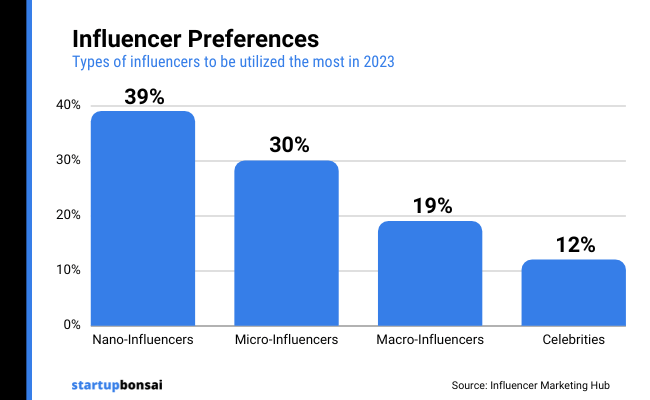
Source: Influencer Marketing Hub1
- 64% of brands said the most important factor they look for in influencers is genuine brand affinity
- The second most important factor was the influencer’s audience engagement rate
- The third most important factor was aesthetic alignment with the brand
Source: Creator IQ & Tribe Dynamics
- 59% of surveyed professionals say influencers can become more valuable to brands by generating more interest & purchase intent
- 51% of surveyed professionals say influencers can increase their value by creating more suitable content for brand
Source: Blogging Wizard
- 39% of brands work with 0-10 influencers
- 21% of brands work with 10-50 influencers
- 16% of brands work with 50-100 influencers
- 11% of brands work with 100-1000 influencers
- 12% of brands work with 1000+ influencers
Source: Influencer Marketing Hub1
What kind of brands do influencers like to work with?
Now that we’ve looked at what brands look for in influencers, let’s flip the script and look at statistics that highlight what influencers look for in brands:
According to Emplifi’s report, the top 5 factors influencers consider when considering a brand partnership (in ranked order) are:
- Personal interest in the brand
- Shared values
- Budget/payment
- Community fit
- Creative freedom
Source: Emplifi
CreatorIQ & Tribe Dynamics also looked at the factors influencers consider when weighing up partnership opportunities in their report, and found that:
- 43% of influencers say the quality of the brand’s product is the most important factor
- 24% say compensation is the most important factor
- 20% say that the brand’s values are the most important factor
Source: Creator IQ & Tribe Dynamics
The same study also found that:
- 78% of creators say they’d stop working with brands due to inadequate compensation
- 64% said they’d stop working with brands due to a poor product or service
- 65% of creators have posted unpaid content for brands they have an affinity with
Source: Creator IQ & Tribe Dynamics
- 70% of influencers prefer working with brands on long-term campaigns
- 23% prefer one-off campaigns
Source: Aspire
Which metrics do influencer marketers track?
Tracking the success of your campaigns is one of the trickiest parts of influencer marketing. There are many different metrics that you can track. Here are some stats about the most important influencer marketing metrics:
- Up to 50% of brands use views/reach/impressions to measure the success of their campaigns
- 25.5% of brands use engagement and clicks to measure success
- 24.9% of brands use sales and conversions to track success
- 71% of brands measure influencer marketing ROI (return on investment)
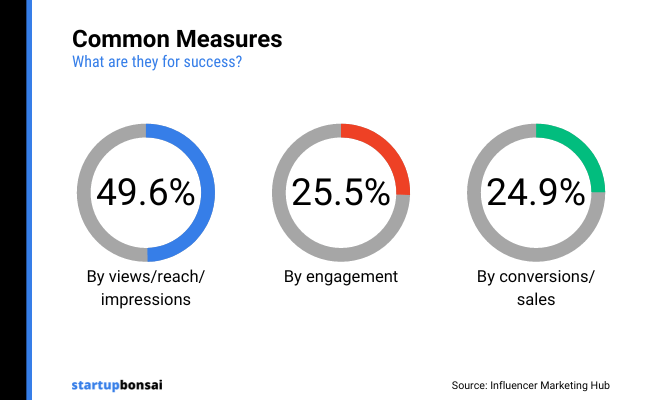
Source: Influencer Marketing Hub1
Influencer marketing engagement statistics
Engagement rates for influencer marketing vary depending on which social media platform you choose to run your campaigns. Here are the average engagement statistics for influencer marketing posts on different social channels:
- Instagram – 852 likes and comments
- Facebook – 68 likes and comments
- Pinterest – 198 post clicks, closeups, and favorites
- TikTok – 6289 likes comments and shares
- Twitter – 245 likes and comments
- YouTube – 78.5k views, likes, comments, and shares
Related reading: 24 Top YouTube Statistics: Usage, Demographics, Trends
Engagement rates also depend on how many followers the influencers you work with have. Nano influencers are the best influencers to work with when it comes to engagement rates.
Here are the engagement rates for nano-influencer posts on different platforms:
- YouTube – 67%
- Instagram – 6%
- Facebook – 2%
- TikTok – 59%
The cost of each engagement also varies depending on the platform you choose for your campaigns. Here’s the average cost per engagement on different social channels:
- YouTube – $0.04
- TikTok – $0.21
- Instagram – $0.57
- Facebook – $2.63
- Pinterest – $5.51
- Twitter – $37.82
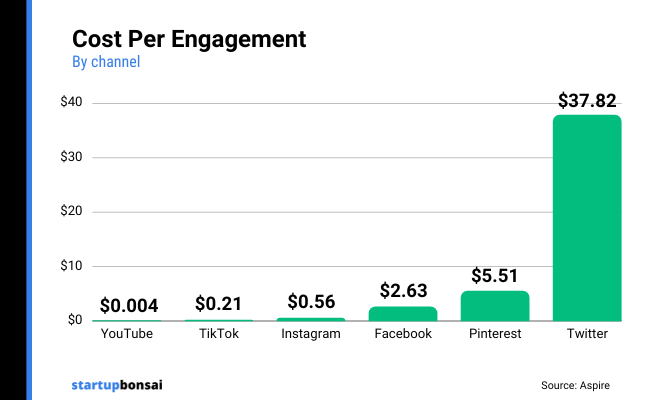
Source: Aspire
How is AI changing influencer marketing?
AI is making waves across the digital marketing industry and influencer marketing is no exception to this. According to Influencer Marketing Hub:
- 47% of marketers say they always use AI for influencer marketing
- 63% of marketers plan to use AI or machine learning to enhance their influencer campaigns.
Here’s how they plan to use it:
- 64% of those respondents plan on using AI/ML to identify new influencers
- 13.3% said they would use AI/ML for content distribution
- 5.6% said they would use it to detect fraudulent influencers and engagement on social media.
- 50.4 of marketers use NLP (Natural Language Processing)
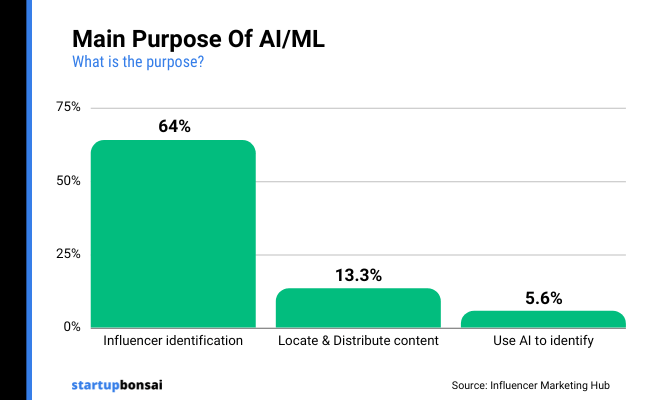
Source: Influencer Marketing Hub1, Influencer Marketing Hub2
Influencer marketers have a lot of hope that AI will change the industry completely, with some brands even considering working with AI-generated influencers for campaigns.
- In fact, 40.9% of marketers think AI will completely revolutionize influencer marketing.
Here are the main pros and cons of using AI for influencer marketing, according to surveyed professionals.
- 31.7% of marketers think the main advantage of working with AI influencers is that they will have increased control over messaging
- 43.8% of marketers, however, are concerned about the ethical implications of using AI influencers for their campaigns.
Source: Influencer Marketing Hub1
Virtual influencer marketing statistics
Interestingly, marketers are also using virtual influencers for campaigns and this practice is on the rise. Here are some key insights into the growth of virtual influencer marketing:
- Over 60% of brands have included virtual influencers in their marketing campaigns
Source: Influencer Marketing Hub1
- CMOs plan to spend up to 30% of their budgets on virtual influencers by the year 2026
- 58% of US consumers follow one of more virtual influencers on social media
Virtual influencers are more common than you might think and many of them have large social media followings. Here’s a list of the top virtual influencers on Instagram:
- #1 – @lilmiquela (2.87m followers)
- #2 – @thalasya_ (466.9k followers)
- #3 – @imma.gram (401k)
- #4 – @leyalovenature (352k)
- #5 – @bermudaisbae (252k)
- #6 – @shudu.gram (239k)
- #7 – @rozy.gram (155k)
- #8 – @soymar.ia (90k)
- #9- @plusticboy (50k)
- #10 – @ai_ailynn (31k)
Source: Emplifi
What do influencer marketers use software for?
There are lots of different tools on the market that claim to make influencer marketing easier. However, not all of them are worth the investment. Here are some stats that show how marketers are using digital tools to improve their influencer campaigns:
- 60% of brands use third-party digital tools and platforms to streamline their influencer marketing campaigns.
- 55% of companies have used an influencer marketing platform to discover new influencers to work with
- 30% use third-party platforms to pay influencers
- 26% use tools to help them to detect fraud and fake followers
- 30% use marketing software for campaign automation
In fact, automating campaigns is becoming increasingly popular amongst influencer marketing professionals.
- 77% of brands think automation is vital for influencer marketing campaigns, which is a rise of 21% since last year.
Source: Influencer Marketing Hub1
Most marketers are not using more than one piece of software to improve their campaigns.
- 88% of brands use up to 3 software tools to manage campaigns
- 47% have increased their spending on influencer software this year.
- 64% of influencers also use software and marketplaces to find brands to connect with
Source: Creator IQ & Tribe Dynamics
What are the top challenges of influencer marketing?
Although having an influencer marketing strategy can be extremely effective, it’s not without its challenges. According to Influencer Marketing Hub, marketers face a variety of challenges when planning influencer campaigns. For example:
- 64% of companies are concerned about fraud within the influencer marketing industry
- 18% of brands find discovering relevant influencers difficult
Source: Influencer Marketing Hub1
- 22% of brands found that scaling their marketing campaigns was one of the most difficult parts of influencer marketing
- 16% said building and maintaining partnerships with influencers was very challenging
Source: Creator IQ & Tribe Dynamics
Sources
- Aspire
- Blogging Wizard
- Collabstr
- Creator IQ & Tribe Dynamics
- Emplifi
- Influencer Marketing Hub1
- Influencer Marketing Hub2
- Klear
- ProfitBlitz
- Rakuten
- Statista1
- Statista2
Final thoughts
There you have it—100+ influencer marketing statistics to inform your strategy. We hope you found them interesting!
While you’re here, you might want to check out some of our other popular statistics posts:
